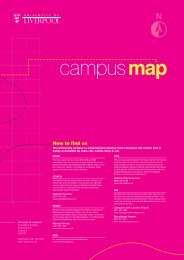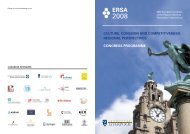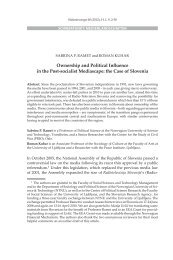The Scientific and Humane Legacy of Max Perutz - Molecular ...
The Scientific and Humane Legacy of Max Perutz - Molecular ...
The Scientific and Humane Legacy of Max Perutz - Molecular ...
You also want an ePaper? Increase the reach of your titles
YUMPU automatically turns print PDFs into web optimized ePapers that Google loves.
ESSAY<br />
Figure 8. Left: In human deoxy haemoglobin the Fe 2‡ ion, attached to<br />
histidine (above), lies slightly above the plane <strong>of</strong> the heme group. Right:<br />
When the Fe 2‡ ion binds oxygen, as in the oxyform, it moves into the plane<br />
<strong>of</strong> the heme. This process is what initiates the sequence <strong>of</strong> resulting<br />
structural changes, see text for further information.<br />
likely to be suitable for use as a cell-free blood substitute. <strong>The</strong><br />
need to develop a blood substitute is now urgent because <strong>of</strong><br />
the increasing concern over blood-transmitted viral <strong>and</strong><br />
bacterial pathogens.)<br />
Earlier, <strong>Perutz</strong>×s pioneering work <strong>of</strong>fered a deeper appreciation<br />
<strong>of</strong> suchtragic diseases as thalassemia, whicharises<br />
because <strong>of</strong> defective synthesis <strong>of</strong> haemoglobin, <strong>and</strong> <strong>of</strong> sicklecell<br />
anaemia. His colleagues at Cambridge, Vernon Ingram <strong>and</strong><br />
John Hunt, showed that sickle-cell haemoglobin differed from<br />
the normal protein merely by a change <strong>of</strong> a single amino acid<br />
residue, in fact the replacement <strong>of</strong> glutamic acid by valine.<br />
<strong>The</strong> Exponential Growth <strong>of</strong> Protein-Structure Determination<br />
In 1953, when <strong>Perutz</strong> discovered that the so-called X-ray<br />
phase problem <strong>of</strong> protein crystallography could be solved by<br />
the method <strong>of</strong> isomorphous replacement with heavy atoms, he<br />
expected that the structures, not only <strong>of</strong> haemoglobin, but also<br />
<strong>of</strong> many other proteins, would presently be solved; [34] but this<br />
did not happen. Only three protein structures had been solved<br />
by 1965, <strong>and</strong> only eleven by 1970. <strong>The</strong> practical difficulties <strong>of</strong><br />
crystallization, <strong>of</strong> preparing isomorphous heavy-atom derivatives,<br />
<strong>and</strong> <strong>of</strong> recording the X-ray diffraction data were so<br />
great that determination <strong>of</strong> each new structure took many<br />
years. Besides, most pr<strong>of</strong>essional crystallographers were<br />
reluctant to enter this risky new field. However, the situation<br />
has now been fundamentally transformed. Since 1975 there<br />
has been an exponential rise in the annual number <strong>of</strong> protein<br />
structures solved (Figure 9). In 1990 over 100 new structures<br />
came to light; but by 2000 approximately 16 000 structures<br />
were known, <strong>and</strong> very many <strong>of</strong> these are <strong>of</strong> direct practical<br />
interest to medicine. If one knows the structure <strong>of</strong> a protein in<br />
atomic detail, then the precise architecture, shape, <strong>and</strong><br />
dimensions <strong>of</strong> receptor centers <strong>and</strong> catalytically active sites<br />
are also known. This situation enables the protein engineer to<br />
improve the performance <strong>of</strong> existing proteins by using various<br />
modern methods. This is now one <strong>of</strong> the major growth areas <strong>of</strong><br />
enzymology.<br />
It is interesting to note that most, but not all, <strong>of</strong> the first<br />
generation protein crystallographers (1960 ± 1980) came out<br />
<strong>of</strong> Britishlaboratories in Cambridge, Oxford, <strong>and</strong> the Royal<br />
Institution, London. (<strong>The</strong> migration <strong>of</strong> D. C. Phillips <strong>and</strong> his<br />
former student Louise Johnson to Oxford in the mid-1960s,<br />
after they had solved the structure <strong>of</strong> lysozyme <strong>and</strong> explained<br />
its mode <strong>of</strong> action, accounts for a shift <strong>of</strong> the center <strong>of</strong><br />
excellence in protein crystallography outside Cambridge from<br />
London to Oxford, although the towering presence <strong>and</strong><br />
achievements <strong>of</strong> Dorothy Hodgkin at Oxford had already<br />
established it as a world-renowned X-ray structural laboratory.)<br />
It is also interesting to reflect, withthe benefit <strong>of</strong><br />
hindsight, how wrong-headed the eminent biochemist <strong>and</strong><br />
Nobel Prizewinner Sir Ernst Chain was when, some thirty<br />
years ago, he advised the MRC in London that medical<br />
researchinvolving crystal-structure analysis was a pr<strong>of</strong>ligate<br />
waste. [35] Suchis the unpredictability <strong>of</strong> science.<br />
From Glaciers to Huntington Disease: <strong>Perutz</strong>×s Earliest <strong>and</strong><br />
Latest Research<br />
As a teenager <strong>Perutz</strong> gained distinction in his school in<br />
Vienna as an expert downhill skier. He was also, at that time,<br />
an accomplished mountaineer, <strong>and</strong> his love <strong>of</strong> mountains <strong>and</strong><br />
glaciers never left him. He claims to have barged into Sir<br />
Lawrence Bragg×s <strong>of</strong>fice one day in the Cavendish making the<br />
untypical claim: I×ve had an honour that you can×t match–<br />
I×ve had a glacier named after me!∫ to which Sir Lawrence<br />
retorted I×ve had a cuttlefish named after me∫. [36]<br />
From his early twenties <strong>Perutz</strong> had a deep interest in<br />
glaciers, particularly how they flowed. Did this occur like<br />
Figure 9. Exponential growth <strong>of</strong> the number <strong>of</strong> protein structures determined since 1975. (Adapted from the web site <strong>of</strong> the Research Collaboratory <strong>of</strong><br />
Structural Bioinformatics (RCSB).)<br />
3162 ¹ 2002 WILEY-VCH Verlag GmbH & Co. KGaA, Weinheim 1433-7851/02/4117-3162 $ 20.00+.50/0 Angew. Chem. Int. Ed. 2002, 41, No.17





